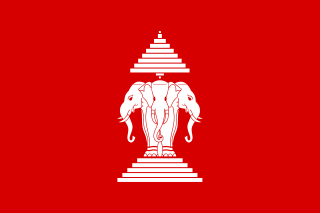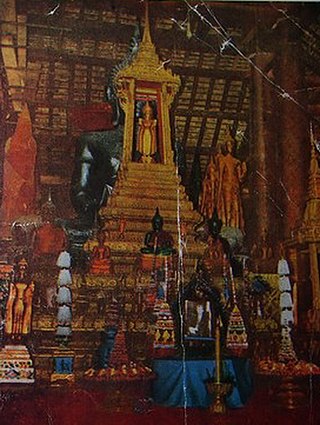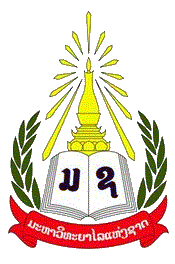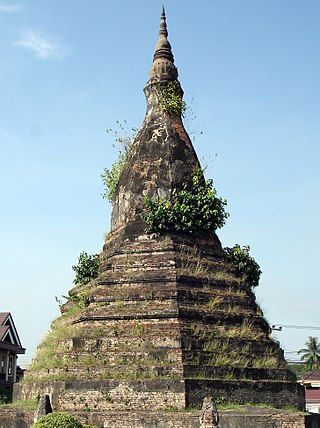
Laos, officially the Lao People's Democratic Republic (LPDR), is the only landlocked country in Southeast Asia. It is bordered by Myanmar and China to the northwest, Vietnam to the east, Cambodia to the southeast, and Thailand to the west and southwest. Its capital and most populous city is Vientiane.

Laos is a country in Southeast Asia. The country's population was estimated at 7.43 million in 2021, dispersed unevenly across the country. Most people live in valleys of the Mekong River and its tributaries. Vientiane Prefecture, which includes Vientiane, the capital and largest city of the country, had 820,924 residents as of the 2015 census. The country's population density is 26.7/km2.

The Kingdom of Laos was the form of government in Laos from 1947 to 1975. Located in Southeast Asia at the heart of the Indochinese Peninsula, it was bordered by Burma and China to the northwest, North Vietnam to the east, Cambodia to the southeast, and Thailand to the west and southwest. The country was governed as a constitutional monarchy beginning with its independence on 22 October 1953. It survived until December 1975, when its last king, Sisavang Vatthana, surrendered the throne to the Pathet Lao during the civil war in Laos, who abolished the monarchy in favour of a Marxist–Leninist state called the Lao People's Democratic Republic, which has controlled Laos ever since.

The Phra Bang is a statue of Buddha in the city of Luang Prabang, Laos; it is the namesake of that city. The statue stands at 83-centimetre (33 in)s, with palms facing forward, cast using thong, an alloy of bronze, gold, and silver. According to local lore, it was cast in Ceylon sometime between the 1st and 9th century. However, the features of the image suggest a much later Khmer origin.

Nong Khai province was formerly the northernmost of the northeastern (Isan) provinces (changwat) of Thailand until its eight eastern districts were split off to form Thailand's newest province, Bueng Kan province, in 2011. Nong Khai province lies in upper northeastern Thailand. Nearby provinces are : Bueng Kan, Sakon Nakhon, Udon Thani, and Loei. To the north it borders Vientiane province, Vientiane Prefecture, and Bolikhamsai province of Laos.

The First Thai–Lao Friendship Bridge is a bridge over the Mekong, connecting Nong Khai Province and the city of Nong Khai in Thailand with Vientiane Prefecture in Laos. The Lao capital city Vientiane is approximately 20 km (12 mi) from the bridge.

Patuxai is a war monument in Downtown Vientiane, Laos, built between 1957 and 1968. The Patuxai was dedicated to those who fought in the struggle for independence from France. In romanizing the name from the Laotian language, it is variously transliterated as Patuxai, Patuxay, Patousai and Patusai. It is also called Patuxai Arch or the Arc de Triomphe of Vientiane as it resembles the Arc de Triomphe in Paris. However, it is typically Laotian in design, decorated with mythological creatures such as the kinnari .

Nong Khai is a city in northeast Thailand. It is the capital of Nong Khai province. Nong Khai city is located in Mueang Nong Khai district.

The National University of Laos (NUOL) is a national public university in Vientiane, the capital of Laos. Founded in 1996, with departments brought in from other existing colleges, it is the only national university in the country. The NUOL accepts students from all over Laos, along with international students.

Tourism in Laos has become an important part of the economy of Laos, contributing US$700 million to the nation's economy, or 4% of GDP. Tourism is governed by a ministry-level government agency, the Lao National Tourism Administration (LNTA).

That Dam is a large stupa located in Vientiane, Laos. The stupa is situated in the middle of the roundabout between Chantha Khoumane road and Bartholonie road.

The Royal Palace in Luang Prabang, Laos, was built in 1904 during the French colonial era for King Sisavang Vong and his family. The site for the palace was chosen so that official visitors to Luang Prabang could disembark from their river voyages directly below the palace and be received there. After Sisavang's death, the crown prince Savang Vatthana and his family were the last to occupy the grounds. In 1975, the monarchy was overthrown by the communists, and the royal family were taken to re-education camps. The palace was then converted into a national museum.

Phongsali or Phongsaly is the capital of Phongsaly Province, Laos. It is the northernmost provincial capital in Laos. The district had about 23,300 inhabitants according to the 2015 Laotian census. It lies at approximately 1,430 metres or 4,690 feet elevation on the slopes of Mount Phu Fa. Phongsali has summer temperatures around 25 to 30 °C, with frequent rain. In winter, from November to March, it is cool and mostly sunny, with daytime temperatures between 10 and 18 °C.

Vientiane is the capital of Laos. Comprising the 5 urban districts of Vientiane Prefecture, the city is located on the banks of the Mekong, at the border with Thailand. Vientiane was the administrative capital during French rule. The city had a population of 840,000 as of the 2023 Census.

Thanaleng station, also known as Dongphosy station, is a freight railway station in Dongphosy village, Hadxayfong district, Vientiane Prefecture, Laos. It is 20 km (12 mi) east of the Lao capital city of Vientiane and 4 km (2.5 mi) north of the Lao-Thai border on the Mekong River. The station opened for cross-border passenger services from Thailand on 5 March 2009, becoming part of the first international railway link serving Laos.

The Laos National Stadium or formally Anouvong Stadium, also known as Vientiane Provincial stadium, is a multi-purpose stadium in Vientiane, Laos. It is named after Chao Anouvong, King of Vientiane. It is used mostly for football matches. The stadium holds 20,000 people. Since 2008, some matches of the Lao League have been played there.

Vientiane Prefecture is a prefecture of Laos, in northwest Laos. The national capital, Vientiane, is in the prefecture. The prefecture was created in 1989, when it was split off from Vientiane province.

The Ethnographic Museum Zagreb is ethnography museum which is located at 14 Ivan Mažuranić Square in Zagreb, Croatia. It was founded in 1919 by Salamon Berger. It lies in the Secession building of the one-time Trades Hall of 1903, designed by the architect Vjekoslav Bastl. The statues in the central part of the façade are the work of Rudolf Valdec. The frescoes on the interior part of the cupola were painted by Oton Iveković.

The National Library of Laos is a library located in Vientiane, Laos. First established on 1 July 1956, it moved to its current location in 1988. The National Library plays an important role in preserving materials about Laos.
Ban Vinai Refugee Camp, officially the Ban Vinai Holding Center, was a refugee camp in Thailand from 1975 until 1992. Ban Vinai primarily housed highland people, especially Hmong who fled the Hmong genocide in Laos. Ban Vinai had a maximum population of about 45,000 Hmong and other highland people. Many of the highland Lao were resettled in the United States and other countries. Many others lived in the camp for years which came to resemble a crowded and large Hmong village. The Royal Thai Government closed the camp in 1992, forced some of the inhabitants to return to Laos and removed the rest of them to other refugee camps.


















